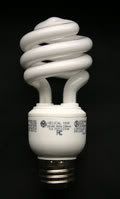Environmental Whacko’s!!
Just heard this story on the radio. These light bulbs (CFL, compact fluorescent lights) are suppose to be the next-best thing in fighting global warming. However, there can be unwanted side effects to owning these “miracles.”
I want to post what a couple sites says of them:
Wherever practical, replace regular light bulbs with compact fluorescent light (CFL) bulbs. Replacing just one 60-watt incandescent light bulb with a CFL will save you $30 over the life of the bulb. CFLs also last 10 times longer than incandescent bulbs, use two-thirds less energy, and give off 70 percent less heat.
If every
They Help Fight Global Warming
CFL's help fight global warming in two ways. First, they operate using less electricity. Second, using a CFL means making less incandescent bulbs-a process that produces carbon dioxide. That means that in places where coal is used to produce electricity (in most places), each CFL will cut carbon dioxide emissions by about 1,300 lbs over its lifetime.
These articles should be titled “How to Make Tuna Uneatable!”, or, “Polluting Our Oceans.”
Safetyland: US$2000 to Clean Up Broken Fluorescent Bulb
Last March 13th, thrifty Brandy Bridges of Prospect, Maine was changing lightbulbs, all by herself. She had decided to replace two dozen incandescent bulbs with screw-in Compact Fluorescent Lamp (CFL) replacements “in an attempt to save money on her energy bill”.
Disaster!—when changing the bulb in her daughter's bedroom, it slipped from her fingers and broke on the shag carpet. Aware of the hazards of broken fluorescent bulbs, she called Home Depot where she had bought the engine of destruction, and was successively referred to the Poison Control hotline, the Maine Center for Disease Control and Prevention, and the Department of Environmental Protection, which sent a “specialist” to measure the mercury levels at the scene of the accident which, indeed, plunging the sensor down into the carpet at the site of the impact, read more than six times higher than the “safe level” of mercury: 300 ng/m³. The ambient air in the room was, however, below this level.
The specialist advised Ms. Bridges not to clean up the disaster site herself, and referred her to Clean Harbors Environmental Services, which duly submitted an estimate of US$2,000 for the job. One month later, Bridges is “gathering finances” for the clean-up; her daughter's room remains sealed up with plastic, the tyke forced to sleep in another room. According to a news story on the calamity published in The Ellsworth American, Ms. Bridges is “worried about her daughter staying in the same house for the next 11 years, potentially having long-term exposure to mercury. She’s worried about the rest of her family’s health.”
For further mercury madness, see this earlier posting; sadly, the story linked to from that article has disappeared into the legacy media memory hole. Tip o' the hat to “jomath” for the pointer, via Jerry Pournelle's Chaos Manor Musings.
Chaos and Chicanery I tell you!
UPDATE
I am posting a list of “how to clean up a mercury spill” from SNOPES
What should I do if a CFL breaks?
Because there is such a small amount of mercury in CFLs, your greatest risk if a bulb breaks is getting cut from glass shards. Research indicates that there is no immediate health risk to you or your family should a bulb break and it’s cleaned up properly. You can minimize any risks by following these proper clean-up and disposal guidelines:
- Sweep up — don’t vacuum — all of the glass fragments and fine particles.
- Place broken pieces in a sealed plastic bag and wipe the area with a damp paper towel to pick up any stray shards of glass or fine particles. Put the used towel in the plastic bag as well.
- If weather permits, open windows to allow the room to ventilate.
What if I accidentally break a fluorescent bulb in my home?
The most important thing to remember is to never use a vacuum. A standard vacuum will spread mercury containing dust throughout the area as well as contaminating the vacuum. What you should do is:
- Ventilate the area.
- If possible, reduce the temperature.
- Wear appropriate personal protective equipment, such as gloves, safety glasses, coveralls or old clothing, and a dust mask to keep bulb dust and glass from being inhaled.
- Carefully remove the larger pieces and place them in a secure closed container.
- Next, begin collecting the smaller pieces and dust. There are several ways to do this. You can use a disposable broom and dustpan, two stiff pieces of paper or one of the many commercial mercury spill kits available.
- Put all material into an airtight plastic bag. Pat the area with the sticky side of duct, packing or masking tape. Wipe the area with a damp cloth.
- Put all waste and materials used to clean up the bulb in a secure closed container and label it "Universal Waste - broken lamp".
- Take the container for recycling as universal wastes. To determine where your town has made arrangements for recycling of this type of waste, call your town office or check out the Maine Department of Environmental Protection website at
http://www.maine.gov/dep/rwm/hazardouswaste/uwmuniciplemaster.xls Remember, the next time you replace a bulb, be sure to put a drop cloth on the floor so that any accidental breakage can be easily cleaned up.
